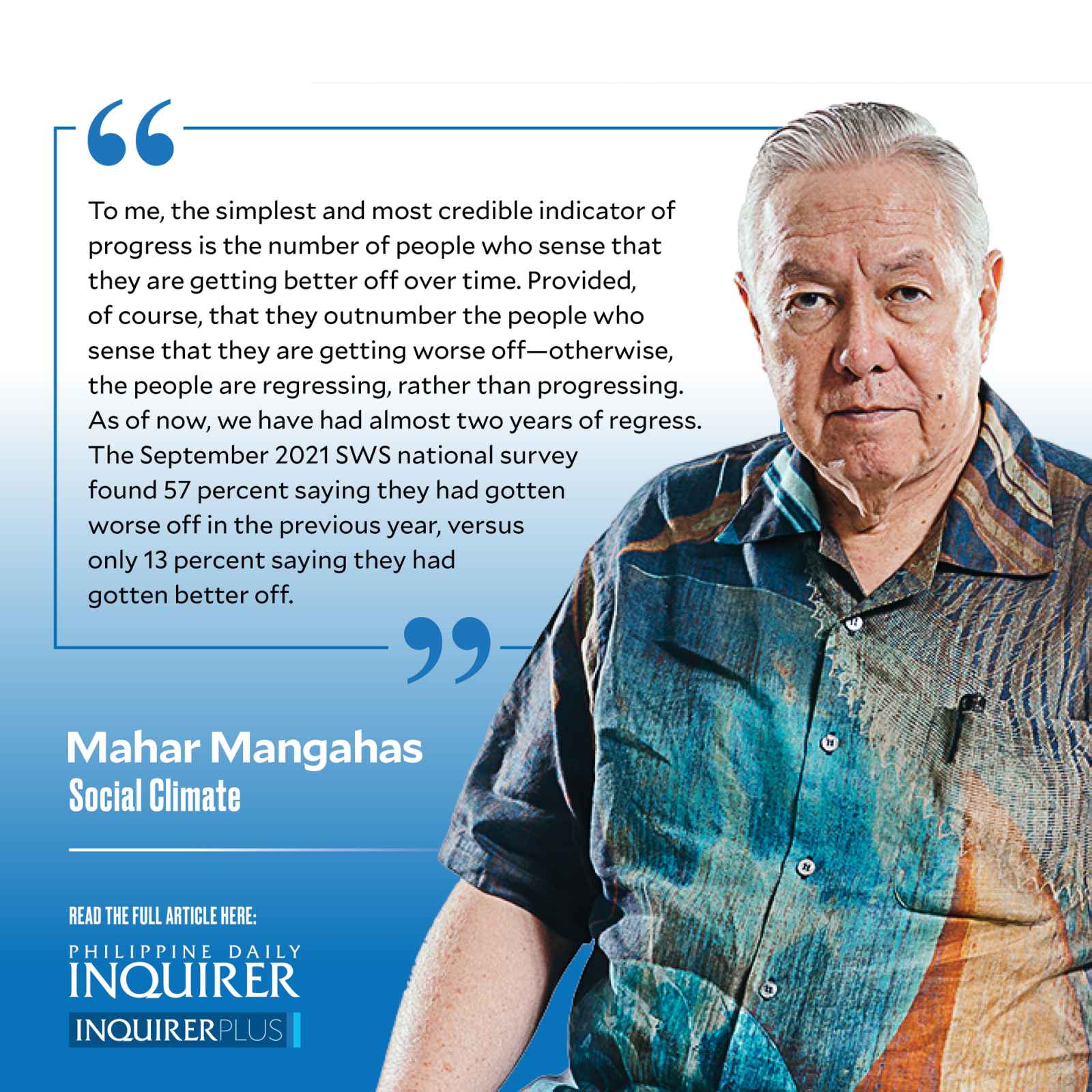Two years of worsening

To me, the simplest and most credible indicator of progress is the number of people who sense that they are getting better off over time. Provided, of course, that they outnumber the people who sense that they are getting worse off—otherwise, the people are regressing, rather than progressing.
As of now, we have had almost two years of regress. The September 2021 SWS national survey found 57 percent saying they had gotten worse off in the previous year, versus only 13 percent saying they had gotten better off. Subtracting the latter (called Gainers) from the former (called Losers) gives an extremely low Net Gainers score of -44 (Third Quarter 2021 Social Weather Survey, www.sws.org.ph: “57% of adult Filipinos got worse off in the past 12 months,” 10/26/21).
Back in September 2020, the base of comparison, SWS found 82 percent worse off than the year before (i.e., September 2019), and only 6 percent better off. This implies that now, in late 2021, there are very many Filipinos who have already endured two consecutive years of worsening, since pre-pandemic time.
The Gainer/Loser item indicates the directional change in wellbeing, rather than the status of wellbeing. A directional change item counts the people on the “Up” and the “Down” escalators, and those not moving, whereas a status item, for instance on poverty, counts those on the “Poor,” the “Borderline,” and the “Not Poor” floors.
This is SWS’ seventh consecutive negative Net Gainers score, going back to May 2020, when it hit its record worst score of -78, which we classified as catastrophic. It stayed in the negative 70s in July and September 2020. It simmered down in the next three surveys, and was -31 last June, but now has bubbled up again.
These last two years of 2020-21 have been a radical U-turn from steadily positive Net Gainers scores in 2015-19—the last six quarters under Aquino III, plus the first 14 quarters under President Duterte (except 2018 Quarter 3, which had a -2). The Philippines went from five years of inclusivity to two years of predominant worsening.
Geographical details. The SWS numbers on Gainers and Losers are directly comparable to those in the Bangko Sentral’s Consumer Expectations Survey (CES), a nationwide quarterly that also uses gainer-loser questions. The CES’ main limitation is that its geographical breakdown has only the National Capital Region and Areas Outside NCR (AONCR). (The late Bangko Sentral Governor Nestor Espenilla Jr. once asked me if the CES could be more detailed; I told him that its sample size was more than enough to separate AONCR into Balance Luzon, Visayas, and Mindanao also.)
The new SWS report shows Net Gainers at -51 in NCR, -41 in Balance Luzon, -46 in Visayas, and -47 in Mindanao. Thus NCR is where the “Down” escalators are presently most crowded. The Social Weather Surveys were designed to provide details for four main areas; users should take advantage of the design.
Relation to indicators of wellbeing status. The enormous economic suffering of the past two years is also clear from the SWS data on wellbeing status, such as Self-Rated Poverty, Hunger, and Joblessness, all surveyed at the same time. We know from experience that these are connected to each other, as well as to Gainers/Losers.
The connections are not in fixed proportions, however. Usually, Filipinos of lower status are also disadvantaged in terms of directional change: Those on the lower floors are also more packed into the Down escalators; the Self-Rated Poor are also getting poorer. SWS will analyze the connections and release them together with the status indicators.
Government analysts tend to be clueless about poverty and hunger, because these are officially measured infrequently. It saves embarrassment, I guess. The last official estimate of poverty was for reference year 2018, and was published in October 2019. The next official estimate of poverty is supposed to be for the year 2021, presumably for release in October 2022, i.e., to be seen only by the next administration, by which time the pandemic might have dissipated.
The significant improvement I see in government statistics is the upgrading of the Labor Force Survey (LFS) from quarterly to monthly, since at least April 2021. The quarterly SWS Joblessness numbers and the LFS numbers track consistently with each other, when the latter’s unemployment plus underemployment are both expressed as proportions of the labor force.
*According to Dr. Dennis Mapa, head of the Philippine Statistics Authority: “The official poverty estimates from data collected by the PSA in 2021 will be released this December 2021 and not October 2022.”
——————
Contact: mahar.mangahas@sws.org.ph




















